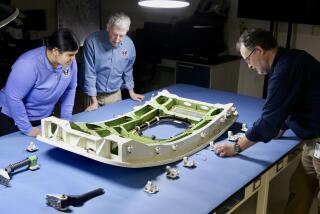Crash Raises Debate Over Stronger Engine Casing Vs. Weight Problems
- Share via
WASHINGTON — Aviation experts said Thursday that the crash of a United Airlines DC-10 in Sioux City, Iowa, probably will revive a long-standing debate over whether aircraft manufacturers should be required to make stronger engine casings that will contain fragments from disintegrating engines.
Preliminary evidence has suggested that flying engine debris may have severed critical hydraulic cables and lines in the fuselage, making the United jet difficult to control.
“There have been a lot of arguments over how much of the engine you can contain,” said C. O. Miller, former chief of aviation safety for the National Transportation Safety Board, which investigates airplane crashes.
Might Affect Control
Miller said that engine casings can be built to withstand exploding engines. But, he said, the added weight that would be needed to make the casings stronger might make the craft less manageable as well as more expensive to fly. Current standards for sheathing equal those for wings, Miller said.
Norman Birch, an aviation safety expert in Palos Verdes, Calif., said that one factor in the amount of damage caused by an exploding engine is whether it is the fan’s blades or the disk on which they are mounted that ultimately breaks apart.
“If a blade breaks, that is going to be contained” by the engine’s casing, Birch said, “but if a disk breaks, the (whole) thing is going to come out (and possibly damage the hydraulic system). There is no way you can contain it,” he said in an interview.
After several other crashes in recent years involving fragments from exploding engines, including a 1985 accident in Milwaukee, some safety experts called for examination of strength and weight standards on the engine housings intended to contain debris. So far, however, there has been no resolution on the invariable trade-offs involving weight, costs and maneuverability.
Two Previous Problems
The DC-10 that crashed Wednesday had two previous engine failures but both occurred several years ago and may have involved engines that subsequently were replaced, Federal Aviation Administration records show.
There also are likely to be questions about whether the configuration of the three independent hydraulic systems in a DC-10 make them dangerously vulnerable to failure from an explosion. The hydraulic system is used to manipulate ailerons, flaps and other aircraft controls.
The agency and industry experts said that the 15-year-old aircraft appeared to be in good shape. Records released by the FAA showed that the plane had a relatively good safety record, with no serious accidents or incidents. United bought the aircraft new in April, 1974.
“The report looks pretty clean,” said Bobbie Mardis, a spokesman for the FAA regional center in Oklahoma City. The earlier engine failures occurred in 1984 and 1980. Neither involved structural damage.
Officials said that they had not yet received the serial number of the tail engine that failed and thus could not determine whether it was involved in the previous engine failures.
The DC-10 involved in Wednesday’s crash had 42,000 hours of flying time--not unusual for that type of aircraft. FAA records show that there are 125 similar aircraft in use by civilian airlines around the world.
Karen Purdy, a spokeswoman for General Electric Aircraft Engines, which manufactured all three jets that the United plane carried, said that the engines have accumulated a reliability rate of 99.95%--meaning that there has been one delay or shutdown for every 2,000 departures.
Industry experts said that another issue the NTSB is likely to investigate is whether the retraction of special “slats” on the leading edge of the wing may have contributed to the accident.
The slats are supposed to help keep the plane aloft. They said that unlike most jetliners, the DC-10 does not have special screws that lock the slats in place in case of hydraulic failure. As a result, the slats can retract and allow the aircraft to fly out of control. In Wednesday’s incident, the jet rolled sharply to the right and the wing dipped as the pilot was attempting to touch down on the runway.
Birch said Thursday that McDonnell Douglas has been criticized in the past for failing to install the screw jacks on its DC-10s.
Keith Takahashi, a spokesman for McDonnell Douglas, said that the DC-10 has three independent and parallel hydraulic systems that are kept “as separated as possible” to reduce chances of their being disabled simultaneously.
“Our engineers say that short of running the lines outside the fuselage, they did their best to keep these lines well separated,” Takahashi said. He said that the plane has no manual backup system.
A spokesman for Boeing, which manufactures the 747 aircraft, said that the configuration of hydraulic lines in 747s was changed after the 1985 JAL air disaster, in which more than 500 people died. In that crash in Japan, the rear bulkhead of the plane failed and severed hydraulic lines that also were clustered in the same area of the tail.
At that time, the lines “all went through the same hole,” but now “they have been separated more,” said spokesman Tom Cole. “That design has been changed.”
The 747, like the DC-10, also has no manual backup systems in the event of a hydraulic failure, experts said, because the parts are too large to be adjusted without hydraulic assistance.
Both McDonnell Douglas and General Electric Aircraft Engines sent teams of experts to the scene to help with the investigation, but spokesmen for both firms declined to speculate Thursday on what may have caused the crash.
Art Pine reported from Washington and Douglas Frantz from Los Angeles. Staff writer William C. Rempel in Los Angeles also contributed to this story.
More to Read
Inside the business of entertainment
The Wide Shot brings you news, analysis and insights on everything from streaming wars to production — and what it all means for the future.
You may occasionally receive promotional content from the Los Angeles Times.










